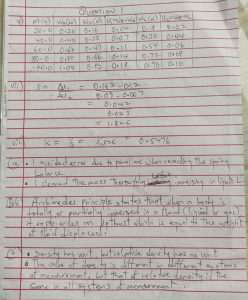Physics Practical Answers 2024
(2bi)*
The first law of refraction, also known as Snell’s Law, states that the ratio of the sines of the angle of incidence and the angle of refraction is equal to the ratio of the refractive indices of the two media. Mathematically, this is expressed as:
n1 sin(θ1) = n2 sin(θ2)
Where:
– n1 and n2 are the refractive indices of the two media
– θ1 is the angle of incidence
– θ2 is the angle of refraction
This law describes how light behaves when it passes from one medium to another, and is a fundamental principle in the study of optics and physics.
*(2bii)*
Given:
Refractive index of the denser medium (n2) = 1.7
Angle of refraction (θ2) = 30°
Refractive index of air (n1) = 1 (approximately)
Using Snell’s Law:
n1 sin(θ1) = n2 sin(θ2)
We can rearrange the formula to solve for θ1 (angle of incidence):
θ1 = arcsin(n2 sin(θ2) / n1)
Plugging in the values:
θ1 = arcsin(1.7 sin(30°) / 1)
θ1 = arcsin(0.85)
θ1 ≈ 58.4°
So, the angle of incidence is approximately 58.4°.
1bi}
Archimedes’ Principle states:
“Any object partially or fully submerged in a fluid (liquid or gas) will experience an upward buoyant force equal to the weight of the fluid displaced by the object.”
Mathematically, this is expressed as:
Buoyant Force (Fb) = ρVg
Where:
– ρ is the density of the fluid
– V is the volume of the fluid displaced by the object
– g is the acceleration due to gravity

